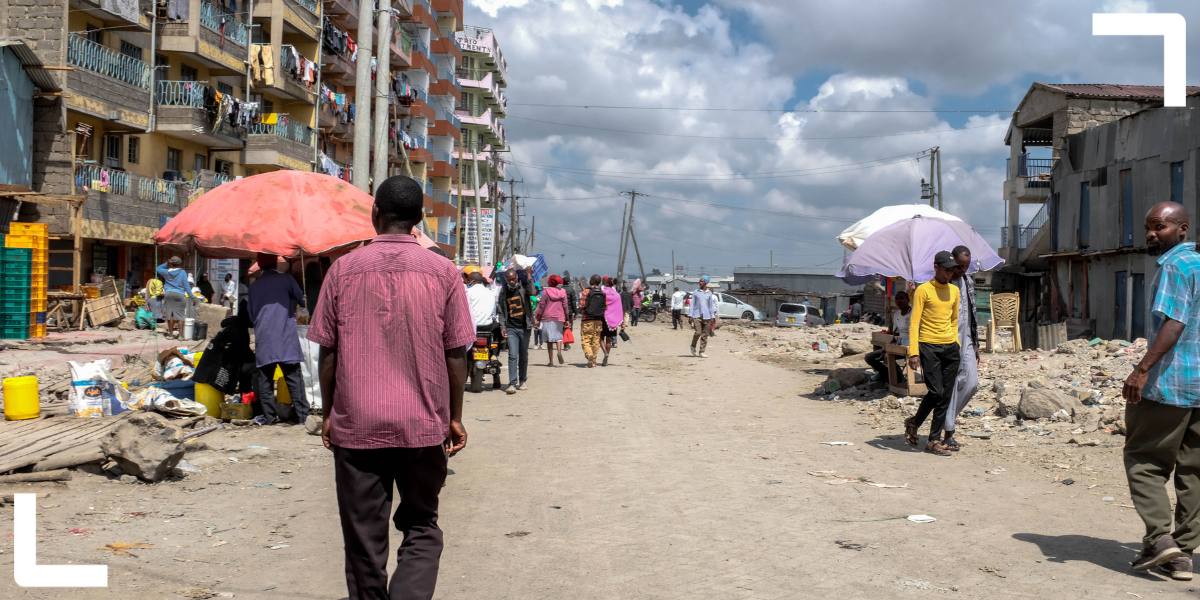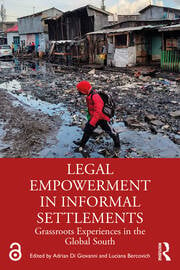The International Development Research Centre, Canada, and the Grassroots Justice Network are excited to announce a new open access volume: Legal Empowerment in Informal Settlements: Grassroots Experiences in the Global South. One chapter is co-authored by ACRC’s Smith Ouma, highlighting the role of legal empowerment in establishing the Mukuru Special Planning Area in Nairobi.
By Adrian Di Giovanni and Luciana Bercovich
Residents of informal settlements encounter a complex array of human rights violations; from systemic discrimination by public officials, to threats to physical security from forced evictions or arbitrary arrests, to a lack of access to basic services, such as housing, water, sanitation and education.
In the face of those challenges, the book features ten powerful case studies, along with two introductory chapters, which show how people living in informal settlements across the global South are using grassroots, community-led justice strategies – known as legal empowerment – to defend their rights and secure more dignified living conditions. The case studies are written by members of the grassroots justice organisations who have supported the settlement communities for years and, in some cases, decades.
Legal Empowerment in Informal Settlements emerged out of a rich process of dialogue, peer learning and review, both online and in person. The chapters echo strong similarities in the challenges and strategies in places as far-flung as the Philippines, Argentina and South Africa. In every case, building community power to defend rights emerged as a central strategy for driving meaningful change.
These chapters speak of complexity, long-term strategies, small wins and tough setbacks. They tell stories of people who fall and rise again, and who don’t give up. More than anything, they offer hope for building systemic change by working with communities.
On a personal note, co-editor Luciana Bercovich notes:
“this project helped me reflect on my own experience. I began working in legal empowerment in 2003, supporting informal settlement communities in Buenos Aires, Argentina. At that time, it often felt like we were figuring things out on our own. In our talks with authors, I often imagined how much a space like this would have meant to a young Luciana starting her journey. I’m grateful to now be able to help create those spaces for others – to recognize, document, and learn from the work of those on the frontlines.”
The following section is an edited extract from the introduction:
The distinctive features of legal empowerment in informal settlements
Legal empowerment is a relatively new and flexible concept that continues to evolve and be redefined with breakthroughs in its implementation in practice. The language of legal empowerment first appeared towards the start of the 21st century to capture “the use of legal services and related development activities to increase disadvantaged populations’ control over their lives”.
Central to legal empowerment are efforts to support “the poor and excluded” to lead the “process of systemic change through which [they] become able to use the law, the legal system, and legal services to protect and advance their rights and interests as citizens and economic actors” (Commission on Legal Empowerment of the Poor & United Nations Development Programme).
Beyond the resolution of an individual or set of disputes, legal empowerment’s use of the law and legal strategies ultimately seeks to shift the power imbalances that drive the denial of the rights of affected groups and the larger injustices they face in society. Over time, a range of definitions has emerged which casts legal empowerment’s goals and methods in broader or narrower terms. The tighter definitions tend to emphasize supporting the agency and capacity of individuals to claim rights on a more case-by-case level, reflecting legal empowerment’s community legal aid roots.
A broader conception of legal empowerment is oriented towards systemic change, and links efforts to addressing structural injustices, socio-economic barriers and shifting power dynamics. Based on experiences across the chapters in this book, we adopt a broader conception of legal empowerment. This conception entails a less circumscribed set of activities, but nonetheless delineates a distinctive boundary between legal empowerment and the complementary social and political efforts to tackle structural problems – again, rooted in power imbalances – like poverty and urban segregation.
Similarly, this conception embraces what Margaret Satterthwaite terms “critical legal empowerment” which emphasizes “community-based efforts to engage the legal system in strategies to shift power downward” and how those efforts use human rights “as a means [to] fundamentally alter unjust systems”.
Addressing human rights violations
There are several common elements distinctive to legal empowerment in informal settlement contexts. The first element, already alluded to, is legal empowerment’s immediate targeting of collective and structural issues, notably the array of human rights violations suffered by informal settlement residents. The challenge at the structural level is to promote stronger social and urban integration, to improve residents’ quality of life and to overcome the visible markers that drive current narratives of stigmatisation and prevent residents from exercising their citizenship and participating in society.
For instance, public policy responses aimed at providing access to services such as sanitation, electricity or water usually encompass all or part of a settlement by their nature and are not as effectively addressed through individual claims. From a practical standpoint, a basic insight guiding several of the case study efforts is that “achieving justice and legal solutions requires multidisciplinary research (lawyers, urban planners, finance specialists, and community organizers) and a mix of legal and nonlegal interventions”. Conversely, the experiences in some of the chapters point to the limits of legal strategies and thus serve as a caution against relying too heavily on litigation or legal remedies, for instance.
The emphasis on collective struggles in informal settlements also shares strong affinities to community lawyering, which sees the need to move beyond atomised, depoliticised or overly individualistic approaches to legal support as essential to achieving systemic change. Communities are at the centre of these approaches: they are best positioned to understand the realities and injustices they face, and should therefore take the lead in any legal action and in defining their own political objectives.
A difference with traditional legal advocacy is that community lawyering mainly prioritises helping to build the capacity, leadership and power of communities more broadly, as opposed to achieving results or legal victories.
Access to public institutions and justice
A main set of challenges in pursuing structural change in informal settlements relates to how residents access public institutions, including justice institutions. Residents tend to live physically close to local governments, state agencies and services providers’ offices, yet nonetheless feel a symbolic distance or barrier. On one level, this distance arises because of the institutional complexity in urban settings. Municipal or local governments have gained an ever-larger set of roles and responsibilities in past decades. At the same time, a range of powers and responsibilities tend to be spread across multiple layers of overlapping or competing provincial or state jurisdictions, institutions and related regulatory frameworks.
Policy approaches to urban poverty and planning have in some cases resulted in contradictory legal frameworks. For example, constitutional or international regulatory frameworks might oblige the state to guarantee the human rights of settlement residents, on the one hand, yet criminal and administrative legal frameworks frequently treat settlements and many of their residents’ activities as illegal, on the other. This tension between applicable legal frameworks is particularly clear in eviction and relocation processes.
As a result, the pathway to seeking accountability is elusive and requires coordinating efforts across a complex network of institutional powers and capacities. Even when the legal protections are clear, a few of the chapters capture how stubbornly entrenched discriminatory and anti-poor government practices can be – with governments seemingly impervious to the illegality of their own practices. Additionally, sweeping changes in policy approaches are common, particularly with changes in government, which can hinder the long-term coherence needed for structural change – and wipe out hard-fought victories, as seen in more than one chapter.
Collective mobilisation
From a tactical standpoint, in the face of this symbolic distance, legal empowerment efforts take advantage of the physical closeness between residents and public officials and institutions in urban contexts and combine an arguably broader and more flexible range of strategies. One set of strategies could be described in terms of political or social advocacy, with communities and residents mobilising collective action and using their physical presence to exert pressure at institutions’ offices and front doors through demonstrations and sit-ins, for example. Similarly, in advocating for change, groups recognise the need for larger coalitions, that is, “strength in numbers” strategies, to achieve a larger and effective voice by and on behalf of informal settlement residents (such as by linking with the media, non-governmental organisations, independent public institutions and other pressure groups).
To illustrate, the team from Nairobi (Chapter 5) describes a petition drive followed by a public demonstration by thousands of women from Mukuru, who marched to the Ministry of Health to demand improved sanitation in the settlement. Physical closeness is also used as a tool to raise societal awareness of the disparities in living conditions of informal settlement residents vis-a-vis residents of the “formal” city, with whom they often live side by side.
Header photo credit: Donwilson Odhiambo / iStock. The aftermath of demolitions in Mukuru Kwa Njenga, Nairobi.
Note: This article presents the views of the authors featured and does not necessarily represent the views of the African Cities Research Consortium as a whole.
The African Cities blog is licensed under Creative Commons Attribution-NonCommercial-NoDerivatives 4.0 International (CC BY-NC-ND 4.0), which means you are welcome to repost this content as long as you provide full credit and a link to this original post.



